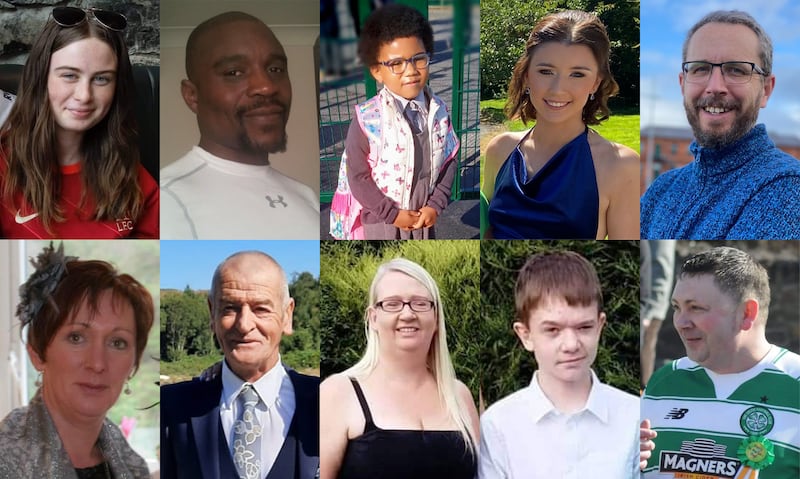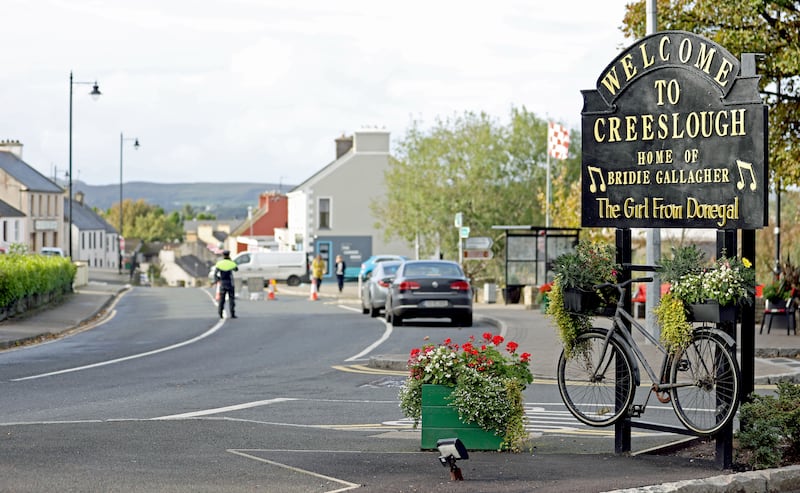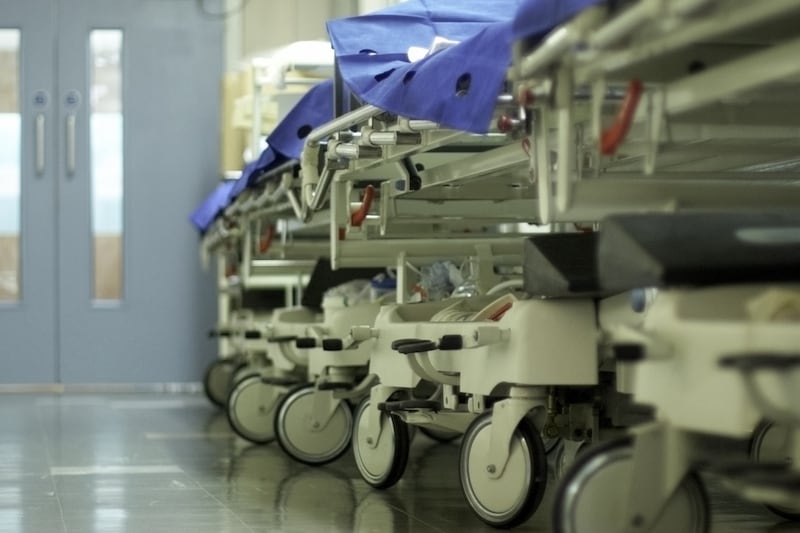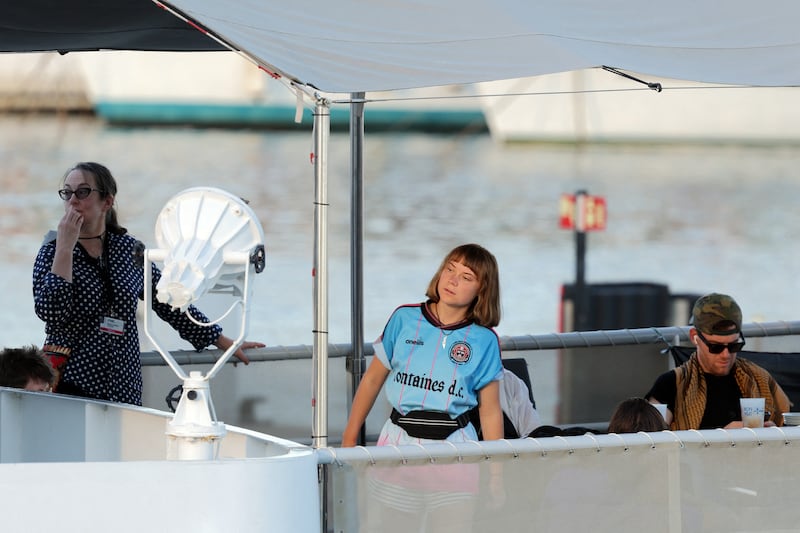Celtic Park, in Glasgow, is one of the most exuberant football cathedrals in Europe but just before Tuesday night’s match, you could hear a pin drop. A minute’s silence was held in honour of the 10 people who died in the Creeslough tragedy. Not even a muffled cough among the crowd of 60,000 disturbed the immaculate and fiercely respectful silence. The floodlights were dimmed to darken the stadium, with just a soft light on the centre circle where the football players from Celtic and RB Leipzig stood arm-in-arm. There was a riveting power in the gesture.
Martin McGill (49), who died in Friday’s explosion at the shop on the edge of Creeslough, was a Celtic fan. He had moved from Scotland in 2001 to help care for his mother, Mary, and became known as a gem of a man; “a kind person where you could see the goodness flowing from him”, as Fr John Joe Duffy said during his homily at the funeral mass. Mourners wore Celtic scarves and jerseys in honour of Martin.
It’s impossible to overstate the passion for Celtic across Donegal: it usually runs parallel with feelings about the county’s Gaelic football team. There is, of course, a good reason for this: a century of migratory traffic between Donegal and Scotland. A few years ago, the former Donegal footballer Eamon McGee interviewed the Scottish comedian Frankie Boyle about growing up in Glasgow with Donegal parents.
“Oh yeah, the Donegal part of our lives was massive,” Boyle said.
READ MORE
Anyone driving from Letterkenny through Creeslough and on to Dunfanaghy will easily grasp why a visitor could look around and realise that something about the place
“We spent the whole school holidays over there at my grandparents. I know where the middle of nowhere is, and it’s somewhere between Crolly and Dungloe. It seemed that the name of the part of Donegal you were in changed about every 15 feet. Technically, it was called Meencorwick, an area that seemed to cover about two houses. It was a totally different life for us; we lived quite a grim existence most of the year in a drab bit of Glasgow. Suddenly we were in the country rounding up sheep, eating seaweed, being driven to the pub, and watching men playing endless rounds of a card game called 25.”
Boyle is 50 years old now. He was recalling the Donegal interior of the 1970s and 1980s. While the wild beauty of the place remains precisely the same, the experience of living there has changed dramatically. In the aftermath of Friday’s explosion at Lafferty’s fuel station, a big delegation of Ireland’s political leaders hurried to Creeslough to pay respects. The most obvious truth about Donegal may have occurred to them on the long journey to the northwest. If you want to see the place, then you must make the conscious effort to go there. For many, Donegal remains an abstract concept because you are never simply passing through.
“I have staged the play among the mountains of my native Donegal, relating my characters to the rock and bog in that grim, beautiful land,” Peadar O’Donnell wrote after completing Adrigoole (1929), one of six novels he would write. The word “grim” may seem a harsh judgment but O’Donnell’s Donegal was before the advent of everyday motorcar use and centrally heated homes and telecommunications, when day-to-day existence, particularly through the depths of winter, must have been physically demanding. The migratory work experience became part of that — having to leave for work and coming home again has always been part of the Donegal reality.
In the aftermath of last Friday’s explosion and the limitlessly courageous rescue efforts, the stories behind the 10 people who died quickly formed a portrait of what Creeslough is like in 2022. Anyone driving from Letterkenny through Creeslough and on to Dunfanaghy will easily grasp why a visitor could look around and realise that something about the place — the bewitching scenery, the relaxed pace of life and easy-going accents, the vibrant community — clicked with how and where they wanted to make a life. So, it becomes easy to understand why Robert Garwe, originally from Zimbabwe, who died in the explosion with his five-year-old daughter Shauna Flanagan Garwe, had come to feel so at home in the village.

Or why James O’Flaherty (48), who grew up in Sydney, moved with his wife to build a home in Dunfanaghy, where they lived with their son, Hamish. He worked from home as an engineer for a multinational company, something that would have been impossible even a few decades ago. And the story of Jessica Gallagher, who had studied fashion in Paris and Shanghai and should have been starting a new job in Belfast this week, spoke, too, of the strong pull of home.
“She was so proud and loved her locality: she loved Creeslough so much,” said Dolores Gallagher, her aunt, during the week. “When she was a student in Paris, one of her assignments was to work on something from home and she produced a beautiful picture of Muckish in the moonlight.”
The landscape and seascape become burnt on to the retinas of those who live there. While it’s true that the shop and accompanying businesses destroyed in the blast was very much a hive of activity in Creeslough, the village itself has plenty of stories of business and creativity born of people’s wish to make a life in the locality and to make things happen. A few weeks ago, the journalist Ciaran O’Donnell sat down with Lorcan Roarty to record an episode of his podcast, Business Matters. Roarty is the owner of the Wild Atlantic Camp, located just a short walk from the ruined fuel station. He was one of the first on the scene and helped some of those injured to safety.
The Coffee Pod, which was quickly transformed into a dispensary of free food and hot drinks in the wake of the disaster, is part of the complex. The glamping site was set up in 2013, in the middle of the recession. Roarty is a quantity surveyor by profession and after he qualified, he moved to the east coast of the United States for work. But his ambition was “to set up roots in Creeslough”. He bought Roses bar, in the centre of the village, in 2004.

Irish pub culture was thriving during the Boom, but it never fully recovered afterwards. The creation of the glamping site came about through a chance conversation. Roarty had been gifted the land by his parents and wanted to build something sustainable. Now, the facility has pods and cabins and is a convenient walk from the centre of the village. It opens all year round: that way, the company can give full-time employment to its permanent staff.
Roarty spoke of other advantages; daily buses to Galway, to Belfast, to Glasgow; the pending Michelin star for the Olde Glen bar and restaurant; the tourist attractions of Glenveigh National Park, of Doe Castle, Ards Forest Park, Muckish and Errigal mountains and the gorgeous beaches.
But it was when reflecting on the evolution of Creeslough over the past decade that Roarty became truly animated.
“Since we opened in 2013, Creeslough has come out of the Celtic Tiger recession quite well. It was no different from any rural village throughout Ireland in that it took a fair hit during the recession. But I do believe that its rebound has been remarkable from its lowest point to where we are today. There is a great spread of new businesses that we have opened here. If we start at the bottom of the village, we have a great new pharmacy that opened since the recession. There’s a fabulous cafe, the Huckleberry, coming up through the village. And Roses bar, we now serve food and that has filled a great gap for gastro-dining in the village.
“Moving up through the village, Scrumptious Ice Cream has opened and is a massive hit during the summertime. Gusto’s takeaway in Creeslough is famous, now, for its fast food and quality. We’ve a new 24-hour launderette opened. The Coffee Pod, serving gourmet sandwiches, has opened up. The Happy Camper, the post office in Creeslough which has been retained, Huckaboard, a really cool idea set up by Cathal Sheridan has taken off massively. We have great fitness facilities in the village now as well which Anton McFadden set up a couple of years ago. And that’s just what I’m naming out to you now, there are others as well. But for a small village like Creeslough, it is unbelievable success in the last 10 or 12 years.”
There are many stories of the unconscious courage of that immediate response which will never be told
It’s a wonderful synopsis of people investing their faith in their place. And it is desperately sad to listen to now. This was the promise and vibrancy which the nightmarish explosion instantly stilled. An accident of such sudden, shocking violence and the ending of 10 lives would be relatively rare and unsettling event in a major city. But in a village the size of Creeslough, where everyone knows everyone, it inevitably leaves a daunting psychological and emotional burden. Everyone used the Applegreen; to get petrol, groceries, to call into the post office or the beauty salon. To use the cash machine; to have a sandwich at the deli.
The everyday innocence of why the victims happened to be there at that moment are heartbreaking because they are so ordinary. Catherine O’Donnell (39) had just met her son James Monaghan (13) — “full of devilment ... full of life and joy” — off the schoolbus. They headed into the shop. Leona Harper, the 14-year-old who made such an impression on all who met her, was staying with a friend for sleepover.
Hugh Kelly (59), from nearby Doe had lived in the community all his life. Martina (Tina) Martin (49) worked in the shop: her voice and face and pleasantries a daily part of life for everyone who stopped in. That was the tableau on Friday afternoon. Had whatever caused the explosion occurred 10 minutes earlier or an hour later, then it would have been different stories, different names and faces.
The sound of the blast was still reverberating when the people in the village began to respond. They haven’t stopped since. There are many stories of the unconscious courage of that immediate response which will never be told. Several of those bereaved spoke of the extraordinary concentration of the digger-driver, a Churchill man who worked through the night, manipulating the big unwieldy instrument with the precision of a surgeon; in a radio interview, a witness said the painstaking care of his movement was reminiscent of the once popular board game Operation.
Last weekend, as vigils were held across Donegal, people struggled to articulate how any community, any town, could reasonably recover from such an unfair and freak visitation of violence.
“It’s a good question,” said Declan Meehan, who organised Sunday’s vigil in nearby Milford.
“This county is used to its share of tragedy. But nothing of this scale. Nothing of this kind before. And I think that we as a larger community across Donegal cannot really comprehend what the long-term ramifications are going to be at this point. It is about having the very direct and immediate resources and supports in place as much as possible.
As all of Ireland and far beyond bore witness to the pain and dignity of the Donegal village, it became apparent that the first tentative steps forward were taking place
“There is going to be a huge need for psychological and counselling services, and just general resources for the town of Creeslough.”
But hints of hope were already taking shape in the breathtaking show of togetherness and grace of everyone involved, from the immediately bereaved to wider friends to the wider community in the area.
“I think the Creeslough community have shown already that they will rally,” Joe McHugh, Fine Gael TD, said on Monday morning last as the sun shone again over the bay in Marble Hill.
“You could see that strength there. And that will continue. Unfortunately, there is an irreversible element to this for families who have lost loved ones. Things will come from the community that will mark this, whatever way that will manifest itself. Unfortunately, previous experience of tragedy in this county has built up a response team that is very, very good. The Inishowen floods in 2017 fortunately had no fatalities but the response was there.
“And there were those eight [men] who died in the car crash in Clonmany in 2010. So, it is all very raw. You must go back to 1935 to the Arranmore [boating] tragedy where 19 people lost their lives for anything like this. And the big thing here, I think, is the total innocence of this. People ... went in for an ice cream. There was no risk. And that is what we are all feeling ... the randomness of it all. This won’t be forgotten.”
There’s an absolute truth in that. In April of this year, Creeslough paid its last respects to Ben McFadden, a local man who was one of those lions of community life: a local historian and musician and a tireless advocate for making sure that Creeslough always had its best side on show.
For 40 years, he was involved in countless local projects from the community association to the Tidy Towns to the Christmas Lights — the small improvements which add up. One of his more recent contributions was to unveil the memorial to mark the 1925 Owencarrow Rail tragedy, which occurred close to the village. Four lives were lost in that accident, almost a century ago. And they have not been forgotten.
Nor will the people caught up in the terrible event of Friday, October 7th be forgotten. A GoFundMe page was set up on the days afterwards by Gerard McFadden, a Creeslough man living in Australia. It has already raised over €423,062 and counting. Gerard is a son of Ben McFadden. Piecing together the fragments of a community left shattered and on uncertain ground after this will be a long and painful and complex task.
But as all of Ireland and far beyond bore witness to the pain and dignity of the Donegal village, it became apparent that the first tentative steps forward were taking place. They could be heard in the compelling Highland radio interview with the Harpers, parents of the late Leona (14), on Monday morning, whose words fell across the county clear as raindrops and, through the sad succession of funerals during the week, in the extraordinary tributes paid by family members to their loved ones.
“We should be grateful,” said 12-year-old Hamish O’Flaherty from the altar at his father James’s funeral mass in Derrybeg. Hamish had stayed in the car that Friday while his father popped into the shop. “For your families. Cherish them.”
Through its unimaginably darkest hour, the best of Creeslough and the deep lands of Donegal shone through. It was most fitting tribute that could be paid to those who were lost.
















